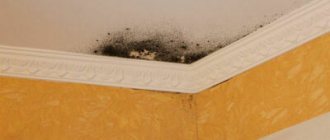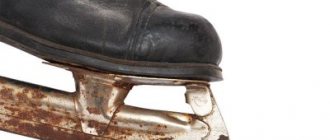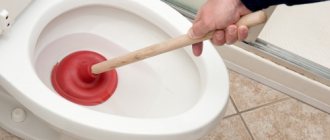The formation of water droplets and a water “film” on pipes in the toilet and bathroom is a common and annoying problem. The appearance of moisture is due to the fact that water vapor present in the air condenses on the coldest objects in the room - usually these are pipes with cold water. At first glance, there is nothing terrible about this, but constant puddles under the pipes do not add order to the bathroom and can cause mold and rotting of materials. Therefore, it is better to remove condensate on cold water pipes.
Causes of droplets of moisture
Condensation can appear as small, almost imperceptible droplets on the surface, or it can be so abundant that it even begins to flow onto the floor and form puddles. This poses a risk to the premises due to increased humidity.
At the same time, water begins to be absorbed into the walls, damaging the fasteners and the pipes themselves. It can also lead to mold in the toilet.
Condensation is formed due to the difference in temperature between the air in the room and the surface of the cold water pipe. Evaporating moisture that does not escape through the vent cools and forms water droplets.
The main reasons for the problem:
- high indoor humidity;
- poor ventilation;
- lack of thermal insulation of pipes.
In an apartment and in a private house - what is the difference?
Water supply systems for private and apartment buildings differ in size. The number of subscribers in the apartment building is very large, which creates conditions for constant cooling of the risers and cold water pipelines.
In a private house, the number of users is limited, so the water moves through the system less actively and has time to heat up a little. These few degrees are enough for the conditions for moisture deposition to change and the process to stop.
If a private house has an autonomous water supply system, then the water is not under strong pressure and flows into the premises more smoothly. Then evaporation appears only due to poor-quality ventilation, which does not have time to remove air supersaturated with moisture.
Fighting methods
Various approaches can be used to combat condensation. The main directions are the restoration of a normal microclimate with good ventilation in the toilet and thermal insulation of water supply lines.
Ventilation
In some cases, the formation of condensation is mainly due to insufficient ventilation in the toilet. To make sure of this, you can leave the door to the room unlocked all night and analyze the condition of the pipes in the morning. If the experiment has shown that a previously wet surface has become noticeably drier, then it is impossible to do without solving the ventilation issue.
There are several approaches to the solution:
You should check whether there is a gap of 10-20 mm under the toilet door.
It is necessary for air access to the toilet. Ways to eliminate the defect are to reinstall the door or install special ventilation valves in it that provide air flow.- Ensuring air flow from the street with more frequent ventilation. One option is to install a supply valve, which allows you to eliminate the problem without opening windows (it can be installed either in the wall or in the frame).
- Installation of exhaust ventilation, which will effectively remove moist air from the toilet. The device is usually installed halfway through a standard ventilation hole. The device can be turned on only when necessary, for example, after wet cleaning, and the rest of the time ventilation will be carried out in standard mode.
- The easiest and fastest way to remove excess moisture is to leave the toilet door ajar more often. This method can be used as a temporary method.
Thermal insulation
High-quality thermal insulation is a very effective method of eliminating condensation . This measure is aimed at eliminating the root cause of the appearance of water droplets on the pipe - the temperature difference between the water in the water supply and the air in the toilet.
Foam covers made of synthetic materials are used as a heat-insulating agent. It can be thermoflex, polyethylene, etc. They are produced in a wide range for different pipe diameters.
Before purchasing a thermal insulation cover, you need to measure the length and diameter of the pipe on which you plan to put it on.
You can install the covers yourself using the following algorithm:
- clean the surface of water supply lines from dust and dirt;
- if there is rust on the metal, it must be dealt with before installing the thermal insulation;
- taking into account all the bends of the pipe in the room, blanks are cut - separate for each straight section;
- on the covers there is a mark running along which each piece must be cut;
- after cutting the workpieces lengthwise, they are put on the pipes, bringing the edges of the longitudinal cuts together with your hands, without additional fixation;
- The bends (turns) of the pipes must be wrapped with electrical tape.
An alternative option is liquid thermal insulation. The composition should only be applied to prepared metal pipes - cleaned and primed. The method of application is chosen to be convenient: spraying, brushing. After the first layer has dried, apply the second. The product dries quite quickly - about an hour.
Air humidity
Poor ventilation is not always to blame for high humidity in the toilet. The reasons may be the following:
Presence of leaks. This could be, for example, water constantly running out of the tank.- When the toilet and bathroom are combined, drying wet laundry.
- Lack (or complete absence) of heating devices. The solution is to install an additional coil.
- Completely fill the coil with wet laundry and rags. As a result, even more moisture evaporates. To prevent this, the heated towel rail and hot water pipes should be as free as possible.
How to choose a steam trap
A steam trap can solve the problem of wet pipes for a long time
Condensate drains are special devices that automatically remove excess moisture. They are installed in places where condensate accumulates the most and are most often used for industrial purposes, but the device can also be installed in a residential area. Depending on the principle of operation and design, steam traps are float, thermodynamic and bimetallic.
- Float The principle of their operation is based on the difference in the physical characteristics of steam and liquid. The devices are equipped with a float and a lever, which are connected by a valve. After moisture accumulates in the housing, the condensate trap is activated, the float rises and releases the excess. Such devices are installed only in heated rooms, as they are prone to freezing.
- Thermodynamic. The device is a tube with a disk; the principle of operation is based on the difference in the speed of movement of steam and liquid. Thermodynamic steam traps are also prone to freezing and are also quite noisy.
- Thermostatic and bimetallic. The mechanism is based on the principle of changing the state of aggregation of a liquid depending on temperature. These are reliable and compact devices that can work in any conditions.
When choosing a condensate drain, you need to take into account different criteria, so it is better to entrust the task of purchasing and installing the device to professionals. Most often, float devices are installed in residential buildings, which are affordable, simple and easy to use.
Also, pay attention to the article on the topic - How to choose a water heater?
Solving the problem of condensation should begin as early as possible - immediately after droplets of water appear on the pipes. If the problem is left to chance, it will cause serious financial costs for replacing the pipeline and repairing the bathroom.
Features of troubleshooting taking into account the material
The material of the pipes also matters when dealing with condensation. An important role in this case is played by such an indicator as thermal conductivity. The lower it is, the less moisture collects on the surface of the pipes.
Metal
Metal pipes cool quickly when cold water passes through them. As a result, water vapor is attracted from the air, forming water droplets.
A water supply system that uses metal pipes requires additional thermal insulation. To do this, use a liquid product or wear special covers.
The use of glass wool, slag wool and other similar materials for such purposes is not recommended. Such options are more suitable for thermal insulation of large highways, rather than pipes in the toilet.
If metal pipes wear out, it is recommended to replace them with plastic ones.
Plastic
Plastic attracts moisture much less than metal . This is due to the lower thermal insulation of the material itself. But in unsuitable conditions, when the room has high humidity and is very hot, the plastic surface can also become wet.
If protection from moisture is required, then thermal insulation is performed with profile covers. Another possible solution to the issue is to sew the pipes into a protective plastic box, which isolates the water supply system from contact with moist air in the room.
Does it need to be cleaned?
The process of moisture deposition itself is not critical , but it is undesirable for walls and other objects surrounding pipes. Absorption of moisture contributes to the destruction of building materials, causing the appearance of fungus, mold, and insects.
If condensation occurs on polymer surfaces in well-ventilated areas, you may not be too afraid of this phenomenon.
It is enough to get rid of the causes of steam deposition, and no harmful consequences will arise.
It is more difficult when steel parts , structural elements of the house, and reinforcement of load-bearing walls get wet.
In these cases, the most effective measures must be taken immediately, including temporarily turning off the water and identifying the source of danger.
Preventive measures
Using preventative measures will prevent problems with condensation on the pipes in the toilet:
correct installation of the door to the toilet, maintaining the gap or installation of valves;- organizing a sufficient number of heating devices in the room;
- organization of good ventilation, including with an exhaust function;
- ventilation of the room;
- removing a large number of wet textiles from a small room;
- eliminating leaks;
- maintaining cleanliness in the room and ventilating the room after wet cleaning;
- organization of thermal insulation of water pipes with cold water;
- when installing pipelines, maintaining the distance between pipes with hot and cold water must comply with the standards and be at least 15 mm;
- areas where cold water communications enter the toilet must be insulated.
Preventive measures require effort and investment, but they will also help you avoid problems with condensation on your toilet pipes in the future.
Hood installation
Even at the stage of construction of residential buildings, specialists create a centralized ventilation system, which avoids disturbances in air exchange and, as a result, the appearance of moisture on the pipes. But sometimes it may not work effectively.
To avoid the formation of condensation, you need to install a forced ventilation system and turn it on regularly. This way, you will be able to get rid of steam or normalize air exchange.
Protecting a pipe from condensation using a thermally insulating coupling Source sense-life.com
Making your own thermal insulation
If you wish, you can insulate the riser yourself. What you will need for this:
- a piece of sandpaper to remove rust;
- phosphoric acid or any other rust converter;
- a piece of fabric (ideally cotton);
- strong thread, twine;
- putty.
Correct pipeline layout Source news.wjct.org
The insulation process is as follows:
- Prepare insulation. Any rag (an old sheet or towel) can become it. It is cut into strips no wider than 10 cm, which are rolled into a roll.
- Clean the surface of the water pipe, additionally degreasing it. Acetone or nail polish remover containing this substance is suitable for this purpose.
- The pipe is coated with a substance called rust converter, and after it dries with putty.
- After it dries, the fabric is wrapped around the pipe. This must be done so that each new turn made covers part of the previous one.
- The rags are soaked with putty.
- Using thread, the fabric is secured to the pipe.
- When the fabric is dry, it needs to be covered again with thermal insulation.
- Finally, a final layer of putty is applied.
- The surface is painted in the desired color.
Condensation in the bathroom on cold water pipes
Before starting repair work, it is important to determine exactly the cause of the problem, which usually consists of the following:
- When a riser pipe gets wet, it's usually a matter of leakage from the neighbors above.
- If a pipe near a plumbing fixture gets wet, then the reason lies in a faulty faucet.
- If problems with ventilation are detected, work will need to be done to remove blockages blocking the hood.
If condensation appears on the pipes in the bathroom: what to do in such cases? When listing ways to eliminate condensation, one cannot help but recall thermal insulation, which quite effectively helps with this problem.
Other condensation protection options
Experts also suggest the following ways to fix the problem:
- Application of isollate. This is a universal material that is suitable for pipe insulation. It is a thermal water-based paint that is applied to the problem riser. After complete drying, it turns into a polymer. The painting process is simple. First, the surface is cleaned and sanded. Afterwards it is degreased and painted with the composition. After it dries, a new layer is applied and so on 4-5 times. Finally, silicone varnish is applied, which makes the surface glossy.
Pipe repair by a plumber Source shvydkoservice.com
- Use of moisture absorbers. This is a household appliance that is designed to combat the problem of condensation on cold surfaces. It is a plastic container containing an absorbent substance.
- Installation of a split system. This option is the most expensive, so it is not suitable for everyone. Equipment with climate control function creates an optimal climate in the room. Such a system must be installed by specialists.
Installing a split system in a room with high humidity Source edilportale.com
Repair of faucet or toilet cistern
If condensation also forms on the toilet tank, the first step is to check its serviceability. The constant sound of flowing water indicates that the tank is not fully filled and is constantly updated with cold water, which produces condensation.
What can be done:
- repair the toilet flush;
- buy a new toilet with a double tank.
A double tank, inside of which there is an additional plastic container, will help completely solve the issue with condensation. Cold water is drawn into it without coming into contact with the walls of the tank, so the appearance of condensation is excluded. The big disadvantage is that the tank is most often sold complete with a toilet and has a fairly high cost.
In a mixer, water control elements most often fail - joysticks, axle-box taps, valves. A thin stream of water leaking around the tap below may be the culprit for the appearance of condensation. Replace the gasket or cartridge and the faucet will be usable again. As a last resort, you can buy a new mixer. Perhaps this will be the end of the search for the causes of condensation.
Don’t put off resolving the condensate issue for too long. And it’s not just about the fact that by sorting it out, you will be doing your health and repairs a great service. Ignoring a problem with unpleasant consequences, while it can be easily and inexpensively solved, is simply unwise.
Use of chemicals
If it is necessary to protect the pipeline from the formation of condensate drops on its surface, you can use special means: Asstratek, Stermizol, Corundum, etc. They are used as follows:
- The surface of the pipe is cleaned of dirt and rust. To do this, it is wiped or sanded.
- To make the mixture adhere better to the surface, it is coated with a primer.
- Using a brush or spray bottle, the substance is applied to the surface. It is advisable to apply at least 4-5 layers to be sure that droplets of moisture will no longer appear on the riser.
- To increase the service life of the pipeline, a fixative is applied on top of the insulating material.
Thermal insulation of pipes with mineral wool Source malivice.ru
If you liked the article, please share it
Previously on the topic:
Share











